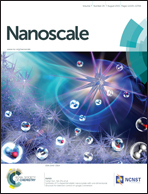Performance enhancement of metal nanowire-based transparent electrodes by electrically driven nanoscale nucleation of metal oxides†
Abstract
Solution-processed silver nanowire (AgNW) electrodes have been considered to be promising materials for next-generation flexible transparent conductive electrodes. Despite the fact that a single AgNW has extremely high conductivities, the high junction resistance between nanowires limits the performance of the AgNW matrix. Therefore, post-treatments are usually required to approach better NW–NW contact. Herein, we report a novel linking method that uses joule heating to accumulate sol–gel ZnO near nanowire junctions. The nanoscale ZnO nucleation successfully restrained the thermal instability of the AgNW under current injection and acted as an efficient tightening medium to realize good NW–NW contacts. A low process temperature (<50 °C), and thus low energy consumption, are required for ZnO nucleation. This made the use of substrates with very low operating temperatures, such as PET and PEN, feasible. The optimized AgNW transparent conductive electrodes (TCE) fabricated using this promising linking method exhibited a low sheet resistance (13 Ω sq−1), a high transmission (92% at 550 nm), a high figure of merit (FOM; up to σDC/σOp = 340) and can be applied to wide range of next-generation flexible optoelectronic devices.


 Please wait while we load your content...
Please wait while we load your content...